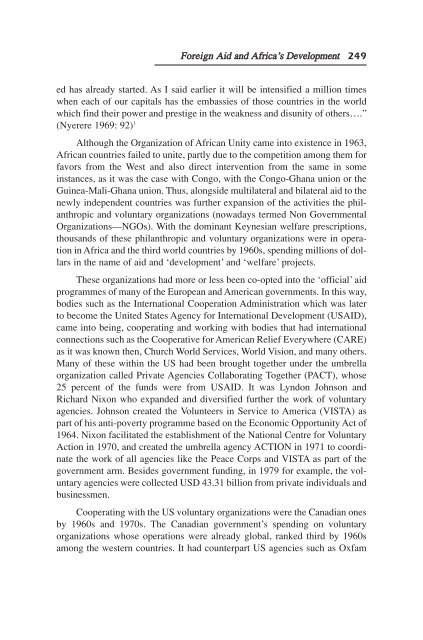EN - FR - Yükselen Afrika ve Türkiye / Rising Africa and Turkey 3
EN - FR - Yükselen Afrika ve Türkiye / Rising Africa and Turkey 3
EN - FR - Yükselen Afrika ve Türkiye / Rising Africa and Turkey 3
You also want an ePaper? Increase the reach of your titles
YUMPU automatically turns print PDFs into web optimized ePapers that Google loves.
Foreign Aid <strong>and</strong> <strong>Africa</strong>’s De<strong>ve</strong>lopment 249ed has already started. As I said earlier it will be intensified a million timeswhen each of our capitals has the embassies of those countries in the worldwhich find their power <strong>and</strong> prestige in the weakness <strong>and</strong> disunity of others….”(Nyerere 1969: 92) 1Although the Organization of <strong>Africa</strong>n Unity came into existence in 1963,<strong>Africa</strong>n countries failed to unite, partly due to the competition among them forfavors from the West <strong>and</strong> also direct inter<strong>ve</strong>ntion from the same in someinstances, as it was the case with Congo, with the Congo-Ghana union or theGuinea-Mali-Ghana union. Thus, alongside multilateral <strong>and</strong> bilateral aid to thenewly independent countries was further expansion of the activities the philanthropic<strong>and</strong> voluntary organizations (nowadays termed Non Go<strong>ve</strong>rnmentalOrganizations—NGOs). With the dominant Keynesian welfare prescriptions,thous<strong>and</strong>s of these philanthropic <strong>and</strong> voluntary organizations were in operationin <strong>Africa</strong> <strong>and</strong> the third world countries by 1960s, spending millions of dollarsin the name of aid <strong>and</strong> ‘de<strong>ve</strong>lopment’ <strong>and</strong> ‘welfare’ projects.These organizations had more or less been co-opted into the ‘official’ aidprogrammes of many of the European <strong>and</strong> American go<strong>ve</strong>rnments. In this way,bodies such as the International Cooperation Administration which was laterto become the United States Agency for International De<strong>ve</strong>lopment (USAID),came into being, cooperating <strong>and</strong> working with bodies that had internationalconnections such as the Cooperati<strong>ve</strong> for American Relief E<strong>ve</strong>rywhere (CARE)as it was known then, Church World Services, World Vision, <strong>and</strong> many others.Many of these within the US had been brought together under the umbrellaorganization called Private Agencies Collaborating Together (PACT), whose25 percent of the funds were from USAID. It was Lyndon Johnson <strong>and</strong>Richard Nixon who exp<strong>and</strong>ed <strong>and</strong> di<strong>ve</strong>rsified further the work of voluntaryagencies. Johnson created the Volunteers in Service to America (VISTA) aspart of his anti-po<strong>ve</strong>rty programme based on the Economic Opportunity Act of1964. Nixon facilitated the establishment of the National Centre for VoluntaryAction in 1970, <strong>and</strong> created the umbrella agency ACTION in 1971 to coordinatethe work of all agencies like the Peace Corps <strong>and</strong> VISTA as part of thego<strong>ve</strong>rnment arm. Besides go<strong>ve</strong>rnment funding, in 1979 for example, the voluntaryagencies were collected USD 43.31 billion from private individuals <strong>and</strong>businessmen.Cooperating with the US voluntary organizations were the Canadian onesby 1960s <strong>and</strong> 1970s. The Canadian go<strong>ve</strong>rnment’s spending on voluntaryorganizations whose operations were already global, ranked third by 1960samong the western countries. It had counterpart US agencies such as Oxfam





